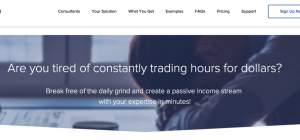 People nowadays are living in Fastlane, everything has to be quick and efficient that matched with the daily schedule of the individual. The tremendous success of Uber, a taxi booking mobile app started the trend of on-demand apps. Further, creating a path for app-based startups to take this major opportunity and make it into something BIG! As a majority of people are getting busier with each day passing, the demand is for Food Delivering Platforms are arising. Thus, making meal ordering and delivering platforms the need of the market.
People nowadays are living in Fastlane, everything has to be quick and efficient that matched with the daily schedule of the individual. The tremendous success of Uber, a taxi booking mobile app started the trend of on-demand apps. Further, creating a path for app-based startups to take this major opportunity and make it into something BIG! As a majority of people are getting busier with each day passing, the demand is for Food Delivering Platforms are arising. Thus, making meal ordering and delivering platforms the need of the market.
This might be the reason why Investors are so keen on investing in these on-demand food delivering platforms. But with attention comes great responsibility, a food delivery startup have to showcase something that its competitors are not able to provide to the customers.
We at ChromeInfotech, a leading mobile app development company, believe that if a food delivery application can cluster orders customer orders while providing a separate fleet of vehicles for delivering purpose in respect to their partnered restaurants. Then, the end-users are more like to opt for that food delivery app for its services in the long run.

These are some of the major players in the food delivery industry: UberEats, GrubHub, Postmates, FoodPanda but new apps like Swiggy and Faasos are seen to be slowly taking over the market. Here, the question arises – “How to maintain the lead?”
Now, this question can be divided into various sub-questions like how to select the right audience, how to approach restaurants for partnerships, what type of on-demand platform to choose and many more. ‘Convenience’ is what customers are focusing on i.e. the demand for mobile on-demand food delivery services is more. Before you proceed it is important to do appropriate R&D and know the characteristics on which the on-demand delivery marketplace works. That includes factors like
- Faster Delivery of products & services
- Excellent Mobile User Experience
- Cheaper pricing for services & products
- Effective Rating system
- Real-time functioning and frictionless payment procedures
Main Categories of Food Delivery Platforms
After studying as well as observing many food delivery applications that use different approaches to on-demand delivery platforms. Below are the main three categories:
Food Delivery Aggregators – The term aggregator can be defined as the one that acts as a mediator between the restaurants and the end-users. This means the user gets to choose from various restaurants through a single platform. Example: The user can sign up on their website or mobile app and gets access to compare prices, check out menus of all restaurants and can also read reviews and provide a rating as per their order delivery. When an order is placed the aggregator forwards to order details to the respective restaurant and collect the fixed commission fee for their service. The orders are then delivered by the restaurants own couriers.
Full-service Food Delivery Platform –This consists of the restaurants and brands that can be called as the ‘Direct Competitors’ that work on the objective of making the food accessible to all as quickly as possible. They offer the full stack takeout solutions that unlike aggregators are a full-service on-demand company that doesn’t include the third parties in their business. These platforms mainly hire an in-staff team of couriers to do the food delivery work. Example – Adding an option to offer the corporate companies is a way to spread business effectively.

New Delivery Platforms – Restaurants that partner with this type of a platform can become quite profitable as they allow convenient delivery services without spending extra money. The new delivery services also allow the users to order from a number of restaurants via a single app. One of the major advances in these new delivery platforms is they offer Logistics services that make it easy for other restaurants to collaborate with them. Example: With this platform, the food delivery apps can cover new verticals of the industry.
Every aspect has its pros and cons and same is with these on-demand application platforms that are the reason why in-depth research is required before selecting a particular approach for your food delivery app.
When it comes to analyzing the cost factor in creating an On-Demand delivery app a SWOT Analysis is a must i.e. an analysis based on the Strengths, Weaknesses, Opportunities, and Threats which are described below:
- Strengths – The strengths stated as competitive advantages in comparison with traditional equipment, the customer loyalty, the growing interest in on-demand services and advantages of both couriers and customers.
- Weaknesses – To establish trust & reliability takes time, not well adapted and the constant need for finding a perfect balance between the demand & the supply.
- Opportunities – The opportunities include factors like faster growth in major or metropolitan areas, in collaboration with many retailers, a relatively new sector with several opportunities and expansion of the products & services offered.
- Threats – There are many threats like rapidly increasing competition, the lack of rules and regulated and many more.

Challenges faced by Food Delivery apps
Many challenges are faced by the on-demand food delivery apps during the time of building and promoting these food delivery applications which are:-
- To identify the right audience to target – With many new food delivery startups are entering the system and competing for the audience. But not exactly knowing what type of customers to target this can further degrade the value of the food delivery platform. Initial step is to define what your target audience is like – is your app delivering groceries or any particular cuisine etc.
- To build partnerships with restaurants – This is a key step that if followed can result in rapid growth of the food delivery platform. To decide which restaurant to choose can be overwhelming as there so many options but again this depends on the set of audience your food delivery app is serving. A mutually agreed contract is signed between both the parties, in order to receive a good publicity to get a larger number of orders.
- Deciding the delivery service your app requires – Without the delivery facility the whole food delivery app is of no use. Delivery services are a means to get the customer’s orders delivered to them in a restrained amount of time. The two major ways to get food delivered are: either by hiring an own glee tog couriers or by getting freelancers for the delivery services.
- To create an appropriate scope of features – The features are what makes the customers come back again but only if they like them. This scope should be designed with respect to three perspectives which are Customer, Courier, and Restaurant.
There is not an assured way of building an on-demand meal ordering app right. But if requirements are the main requirements are met in your food delivery app that can help you in covering more audience. Provide services that are flexible like delivering food 24/7 that will cover both types of people that work in a day or night shifts. But the most important thing is the applying continuous effort in the right direction.







